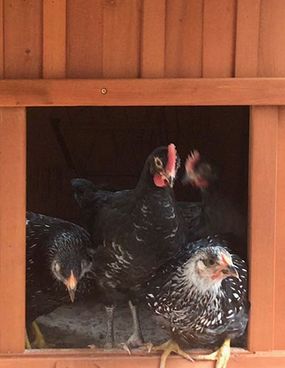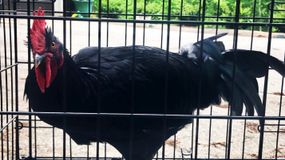A male chicken goes by several different names depending on its age and status in the flock. The official term for an adult male chicken is a rooster. However you may also hear people refer to male chickens as cocks or cockerels. Understanding the differences between these terms can help you better understand chicken anatomy, behavior and purpose on the farm.
Cock vs Rooster: A Matter of Decency
Cock is the traditional term used to describe an adult male chicken It dates back centuries and derives from Old French and Latin words meaning “male bird”
However, during the 17th century, the word cock took on some inappropriate sexual connotations in English slang. As a result, the term rooster became more popular as a more “decent” word for a male chicken.
Nowadays, the two terms are generally interchangeable when referring to a mature male chicken. Rooster is the most common in everyday use, while cock is still used in poultry husbandry and exhibition circles.
The Life Stages of a Male Chicken
Here’s a quick rundown of the names for a male chicken during the different stages of its life:
-
Chick – A newly hatched chicken of either sex
-
Cockerel – A young male chicken under 1 year old
-
Cock or Rooster – A sexually mature male over 1 year old
So, a male chicken is called a cockerel from the time it hatches until it reaches sexual maturity around age 1. At that point, it becomes a cock or rooster.
Identifying the Rooster
How can you distinguish a rooster from a hen? Here are some of the most noticeable characteristics:
- Bright red comb and wattles on head
- Longer, pointed hackle feathers on neck and back
- Longer legs with thicker thighs and sharp spurs
- Longer, iridescent saddle and tail feathers
- Crowing and aggressive behavior
Roosters have more vivid plumage with hackles and saddle feathers that are longer and pointier. This makes them appear larger and more impressive to hens and competing roosters.
The Rooster’s Role in the Flock
As the alpha male, the rooster has several important jobs:
- Announcing dawn and dusk with his crowing
- Watching for threats and protecting hens from predators
- Mating with hens to fertilize eggs
- Establishing pecking order and keeping hens in line
The rooster uses his size, spurs, and aggressive behavior to defend the flock. He crows to communicate with hens, warn off intruders, and signal his status. Although hens don’t need a rooster to lay eggs, he ensures the eggs can hatch into chicks.
Caring for Roosters
Here are some tips for keeping roosters healthy:
- Feed a high protein ration of at least 16% protein
- Provide at least 4 square feet of coop space per bird
- Trim overgrown nails and spurs regularly
- Handle mean roosters gently and often to tame aggression
- Limit treats to avoid obesity
With proper care, a healthy rooster can live 5-8 years or longer. Make sure to trim spurs and nails as needed since they keep growing throughout the rooster’s life.
Fun Rooster Facts
-
Roosters have excellent vision and can spot threats up to 100 yards away.
-
The average size of a rooster’s comb indicates testosterone level and fertility.
-
Roosters will sometimes mate with hens purely for pleasure, not just reproduction.
-
Dominant roosters will mate more but don’t actually fertilize more eggs than subordinate males.
-
Roosters crow because their circadian rhythm tells them when it’s time to signal the flock.
Understanding the stages, role, and needs of roosters will help you successfully raise them alongside your hens. With good management, roosters can serve as productive and protective members of the flock.

Can Female Chickens Change Sex?
Miss Lucille was a sweet little pullet (young hen), who found a cozy home in the chicken coop of Kristi Allens (not her real name) Powder Springs, Georgia, backyard. Initially, things appeared to be status quo with the young exchequer leghorn cross.
After observing her for a time, however, Allen noticed Miss Lucille was growing a comb. Although both sexes of the breed can have them, Allens instincts told her that perhaps something wasnt quite standard, so she sought the help of a local farmer. Allen recalls:
Advertisement “The farmer did all of the checks to confirm Miss Lucille was a miss. She had no long saddle feathers [pointy feathers at the base of the tail], no aggression, didnt jump or react in the presence of all the hens and roosters, and when she was laid back in the farmers hand, she stuck her legs out straight and just laid there. All are old timers tricks to identifying adult roosters since theres no definitive way to tell until they mount another chicken or crow, aside from lab testing.”
Miss Lucille had “failed” the rooster test. However, later on, Allen arrived home to a mess of feathers in the backyard, an unusual event because female chickens dont usually molt until around 18 months. She also started exhibiting more aggressive behavior.
“She began acting more temperamental, but I attributed that to her molting, as it can be quite uncomfortable for chickens,” she says. “I was worried about her health.”
Although strange things were certainly afoot in Miss Lucilles world, none of them were health-threatening. When her feathers grew back, they were pointed saddle feathers, signaling a transition to an adult male chicken. Her hackles and tail feathers had also undergone some major changes.
“She went from being your typical hen to a rooster with beautiful, long tail feathers and pointy hackles. Her gait changed, and she was definitely at the top of the pecking order,” Allen says.
Further consultation advised a wait-and-see approach. One farmer told her, “Just because she now looked like a rooster didnt mean she was one. I needed to wait until she crowed or mounted one of the hens.”
Ironically, Miss Lucille became more mellow and friendly. “But then her comb kept getting bigger and redder. For every indicator she might still be a she, there was another for her being a he,” she says.
Finally, the irrefutable proof came at around 5 months of age: The rooster literally crowed. “Every day the crow grew louder and stronger. It was official that Miss Lucille was now Mr. Lucille,” Allen says.
“And to his credit, he assumed the role wonderfully. If the girls were low on water, hed crow and let me know to get on it. Hed lead the charge up to roost at night. Hed wake us up with his song early each morning.”
Identifying an Adult Female vs. an Adult Male Chicken
When chicks mature, chicken breeders use a few visual signifiers to distinguish roosters from an adult hen.
The most obvious features between them are the rooster combs and wattles: flaps of skin that indicate high levels of testosterone and may also signal that the rooster is ready to fight off any male rivals. Most breeds of roosters feature a bright red comb for maximum visibility.
Other common indicators are the development of leg muscles and orientation of feathers. As they become ready to lay eggs, most adult female chicken breeds develop thicker legs with short, stubby claws. Meanwhile the same breed of roosters tend to retain long legs with sharp claws on their feet for defense.
Hen feathers tend to be soft and plush all along the body, while the rooster grows coarser, more exaggerated feathers. Hens keep short, rounded hackle feathers for their whole life, while most male chickens develop long and ornate hackle feathers along the ridge of their back.
Then there are the long saddle feathers, which populate the tail area and either point rearward or fan out to make the rooster appear larger to foes.
The DIFFERENCE Between ROOSTERS And HENS
FAQ
What do you call male chickens?
Rooster. A male chicken (includes cock and cockerel)
What is a male and female chicken?
Cockerel: a young male chicken. Hen: an adult female chicken.
Are male chicken roosters?
So, even though all chickens roost, they changed the designation for a male chicken from roost cock to rooster. Nevertheless, a young rooster is still called a cockerel.
What do we call female chickens?
A female chicken is known as a hen when it is an adult, and it is known as a pullet as a female juvenile. An adult male is known as a rooster, while a juvenile male is called a cockerel. Both male and female baby chickens are known as chicks.


